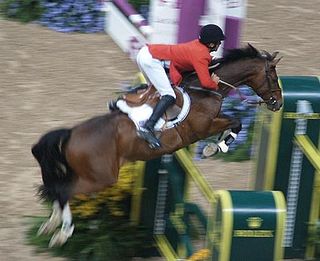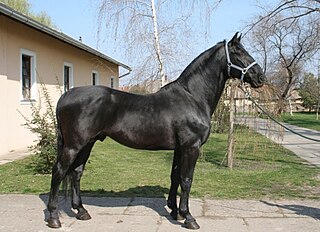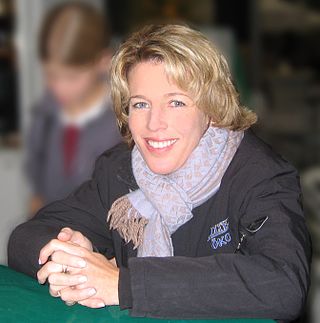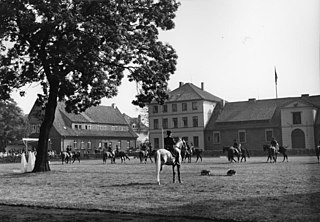
The Byerley Turk, also spelled Byerly Turk, was the earliest of three stallions that were the founders of the modern Thoroughbred horse racing bloodstock.

A Hanoverian is a Warmblood horse breed originating in Germany, which is often seen in the Olympic Games and other competitive English riding styles, and has won gold medals in all three equestrian Olympic competitions. It is one of the oldest, most numerous, and most successful of the Warmblood breeds. Originally a cavalry horse, infusions of more Thoroughbred blood lightened it to make it more agile and useful for competition. The Hanoverian is known for a good temperament, athleticism, beauty, and grace.

The Oldenburg or Oldenburger is a warmblood horse from the north-western corner of Lower Saxony, what was formerly the Grand Duchy of Oldenburg. The breed was built on a mare base of all-purpose farm and carriage horses, today called the Alt-Oldenburger. The modern Oldenburg is managed by the Association of Breeders of the Oldenburger Horse, which enacts strict selection of breeding stock to ensure that each generation is better than the last. Oldenburgers are tall sport horses with excellent gaits and jumping ability. The breeding of Oldenburg horses is characterized by very liberal pedigree requirements and the exclusive use of privately owned stallions rather than restriction to a state-owned stud farm.

The Holsteiner is a breed of horse originating in the Schleswig-Holstein region of northern Germany. It is thought to be the oldest of warmblood breeds, tracing back to the 13th century. Though the population is not large, Holsteiners are a dominant force of international show jumping, and are found at the top levels of dressage, combined driving, show hunters, and eventing.
Gem Twist was a 16.3 hands world champion American Thoroughbred show jumping horse registered under the name Icey Twist. Bred by equestrian Frank Chapot, Gem Twist had an incredible career at the Grand Prix level. The gelding is the only horse to have won the "American Grand Prix Association Horse of the Year" title three times, and is regarded as one of the best show-jumpers in history.
Furioso (1939–1968) was an influential sire of sport horses, and is found in the pedigrees of many top show jumpers today.
Furioso II (1965–1986) is one of the most influential sires in sport horse history. His offspring have performed well in all disciplines of show jumping, including at the Barcelona and Sydney Olympics.
Cor de la Bryère, nicknamed "Corde", is one of the most influential sires in modern warmblood breeding. He is known as the "Reserve Stallion of the Century", second only to Landgraf I. He stood 16.2 hands.
Rantzau (1946–1971) was a French-bred racehorse that went on to be an extremely influential sire of dressage, show jumping, and event horses, and is considered to be one of the most influential stallions from the French studbook. Rantzau stood 16.1 hands.

Bay Ronald was a Thoroughbred racehorse that had a huge impact on the breeding of sport horses, mainly through his son Dark Ronald and grandson Teddy, and also carried on his lines in theThoroughbred racing world, through his son Bayardo. He appears in the pedigrees of many dressage, show jumping, and eventing horses today.

Dark Ronald was an English bred Thoroughbred racehorse and sire with a global influence on the breeding of Thoroughbreds and sport horses, with many show jumpers tracing back to him.
Bolero (1975–1986) was a dressage horse and an influential sire. He stood 16.1 hands.
Voltaire was an influential sire of show jumpers and dressage horses. Additionally, he competed successfully at the international level in show jumping.

Der Löwe (1944–1973) was a successful stallion who had a great impact on the breeding of Warmbloods and is thought by some to be one of the most important post-war stallions to stand at stud.

The Westphalian or Westfalen is a warmblood horse bred in the Westphalia region of western Germany. The Westphalian is closely affiliated with the state-owned stud farm of Warendorf, which it shares with the Rhinelander. Since World War II, the Westphalian horse has been bred to the same standard as the other German warmbloods, and they are particularly famous as Olympic-level show jumpers and dressage horses. Next to the Hanoverian, the Westphalian studbook has the largest breeding population of any warmblood in Germany.

The Nonius is a Hungarian horse breed named after its Anglo-Norman foundation sire. Generally dark in color, it is a muscular and heavy-boned breed, similar in type to other light draft and driving horses. The breed was developed at the Imperial Stud at Mezőhegyes, Hungary by careful linebreeding. Originally bred to serve as a light draft and utility horse for Hungary's military, the breed became a useful agricultural horse during the 20th century. The depredations of World War II significantly reduced the Nonius' population, and in the decades after the war, a downturn in the usage of horses in Hungary sent many members of the breed to slaughter. Today the breed is bred by preservationists and is used in agriculture, leisure riding, and competitive driving sports. The largest numbers of Nonius horses are still found at Mezőhegyes, with representatives in other eastern European nations as well.

Meredith Michaels-Beerbaum is an American-born German equestrian who competes at the international level in show jumping.

Donnerhall was a dressage stallion who was known not only for having a successful career as a sport horse, but also passing on his abilities to his offspring to become an influential sire.

The Zweibrücker is a type of German warmblood horse bred in Rhineland-Palatinate and Saarland. Traditionally, the breeding of Zweibrücken was centered on the onetime Principal Stud of Zweibrücken but since 1977 has been under the jurisdiction of the Horse Breeders' Association of Rhineland-Palatinate-Saar (PRPS). The modern Zweibrücker is an elegant, large-framed, correct sport horse with powerful, elastic gaits suitable for dressage, show jumping, eventing and combined driving.

Celle State Stud is a state-owned facility for horse breeding in Celle, Germany. The State Stud of Celle, located in what is now known as Lower Saxony, was founded in 1735 by order of George II, King of Great Britain, Elector of Hanover and Duke of Brunswick-Lüneburg. Its purpose was to make high-quality stallions available to local breeders. Several wars affected not only the safety of the horses, but the types of stallions housed there. Celle's history is intertwined with the history of the Hanoverian horse breed, but the breed registry is privately owned and is an entity independent of the stud. Today the state stud is known for its annual stallion parades.












